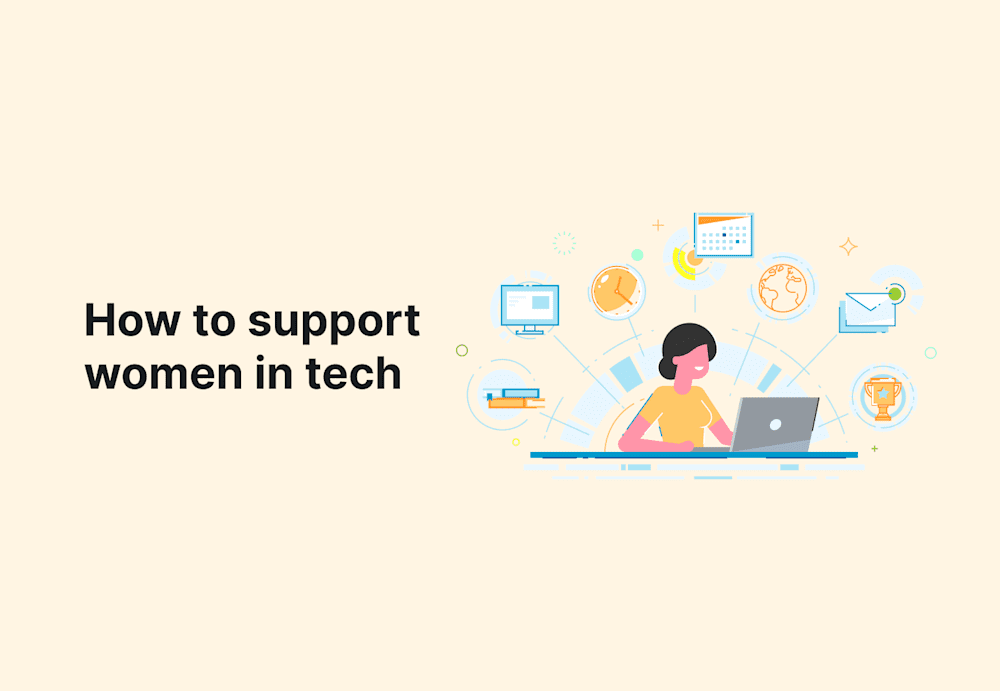The tech industry has a reputation for being a bit of a boys’ club. It’s no secret that women are especially underrepresented in information technology and computer science. They also frequently face sexism, underpayment, lack of job promotions, and the sense they need to work harder than a male employee. Not only is gender equality a moral imperative, but it can reap tangible business benefits, including enhanced performance and increased innovation. That’s why it's critical to support women in tech.
Everyone needs backup sometimes. Heck, Frodo had a whole fellowship helping him. So don’t be afraid to help a female tech hero along on her journey. Supporting her in no way diminishes your own accomplishments.
Regardless of your gender, learning how to support women in tech can help your tech company do its best work while being more welcoming. As a bonus, these methods to support women in the technology industry are also effective for supporting other underrepresented groups, including anyone historically marginalized based on race, ethnicity, culture, religion, gender identity, sexuality, immigration status, first language, socioeconomic status, disability, age, and education level.
The role of women in tech
Women make up 47% of the U.S. workforce. However, the five biggest tech companies (Amazon, Meta, Apple, Google, and Microsoft) average under 36% female employees. Around 30% of leadership positions and 24% of tech roles in these giants are held by women. AnitaB.org’s Top Companies for Women Technologists 2023 sheds more light on gender diversity among technologists in the U.S.:
Around 29% of technologists are female.
Combined, women who are Black, Latinx, multiracial, Native American, and Pacific Islander make up around 5% of all technologists in the U.S.
Female representation decreases as career level increases.
Representation fell in 2020 but is rebounding.
All this shows that women are woefully underrepresented in tech. And while many in the industry now recognize the problem, progress is slow. Thankfully, you can help tackle the issue.
Understand gender bias
You’ll never find a solution if you don’t see a problem. Humans are naturally prone to unconscious biases, which are stereotypes that we’re unaware we believe. These views can shape how we treat each other. Unconscious bias is a lot like a slow water leak. If there are a few drips here and there, you might not notice. But over time, the effects can accumulate until they’re impossible to ignore. Understanding bias and reflecting on our own underlying assumptions can help create a more hospitable environment for women.
Unconscious bias training aims to tackle biased thinking head-on. Learning resources are available at all price points (including free options), so any company can educate its workforce. Unconscious bias training is especially valuable for hiring managers since their beliefs can shape who gets the job.
Use inclusive language
Gendered language is deeply engrained in our vocabulary, but it’s worth the effort to weed it out. For instance, terms like “chairman” and “businessman” can seem exclusionary. Instead, consider using “chair” and “business professional.”
While these differences may seem minor, they can make a huge impact. A report by Appcast found that job postings with gender-neutral language received 29% more applications. One study even suggests that if males use gender-neutral language, it may promote more favorable attitudes toward women and LGBT individuals.
Acknowledge achievements
Women are underrepresented in the tech sector but even more underrepresented in tech leadership roles. This may be due in part to a hesitancy to self-promote their skills and accomplishments. Research indicates that publicly highlighting a woman’s performance increases her willingness to lead.
Don’t hesitate to point out if a colleague has done a great job. At the same time, don’t be afraid to acknowledge your own achievements. It’s not bragging unless you make it bragging. Just stick to the facts, give credit where it’s due, and avoid belittling others. Everyone can bask in their glory together.
Provide continuing education
Technology changes at a breakneck speed, so ongoing training is critical. Don’t get us wrong: You should support professional development for all your employees — not just women. However, it can be particularly valuable for companies looking to close the gender gap.
Women often feel less confident in their computer skills than their male counterparts. This self-doubt may hold them back from pursuing a leadership role, or it may even encourage them to look for work in another field. Training can help build confidence, helping women recognize they’re truly good at their jobs. In turn, this can help with retention and advancement.
Additionally, on-the-job training for women interested in technical roles can help close the digital skills gap. By 2030, skill shortages may result in 85 million unfilled jobs around the world. Women are a massive untapped resource. Less than 30% of women even consider a tech career compared to over 60% of men. Training programs can help female talent who hadn’t previously seen a technical role as an option to pivot their careers.
Promote a supportive culture
An inclusive culture can make the office a friendlier place for everyone. Developing such a culture often starts at the top. Senior leaders must display inclusive behavior themselves, including showing empathy, delegating opportunities fairly, communicating inclusively, encouraging open dialogue, and supporting the growth of female tech talent. Other company-wide methods of cultivating an inclusive culture include:
Making inclusion a core value
Providing DEI training
Promoting employee resource groups (ERGs)
Encouraging employee-driven events
Allow flexibility
Since the start of the COVID-19 pandemic, virtually everyone in the tech workforce values flexibility. Allowing employees to shift their work schedules, work from home, and take time off as needed can help improve their work-life balance and your retention rates. While most employees won’t argue against a more flexible working environment, it’s often most important for women.
Unpaid caregiving, whether for children or older adults, disproportionately falls on women. In 2023, over 26% of women reported providing unpaid care compared to under 17% of men. They also reported spending about twice as long on caregiving activities each day than the average man.
For working women, this extra labor can hold back their career aspirations. A workplace with greater flexibility makes it easier for women to fulfill both their career and personal commitments.
Put women in leadership roles
While 82% of Americans agree that women should enjoy the same opportunities for career advancement, just 34% feel their workplace makes it a high priority to have women leaders. A female leader can be invaluable in several regards:
Provide a role model for other women
Promote more inclusive policies
Enhance teamwork
Bring new perspectives
Develop a support network
In a male-dominated field like tech, a female employee can easily feel isolated and risk burnout. Developing a support network provides an outlet to ask questions, share struggles, seek advice, and find support. Luckily, there’s no shortage of communities dedicated to women in tech.
Mentorship programs and ERGs can serve a similar function, giving women an opportunity to share their knowledge and help each other.
Amplify female voices
Allyship is critical to equity. All too often, women are overlooked or ignored. When we see that happening, any of us can step up to amplify their voices.
Women in the Obama administration are credited with pioneering the amplification technique. They often weren’t invited to important meetings. Even when they got a seat at the table, they struggled to be heard. That’s where amplification came to the rescue. When a woman raised a good point that many ignored, other women at the table would repeat it and credit its author. This redirected attention to the idea and prevented others from later claiming it as their own.
While the strategy was originally developed as a way for women to support other women, anyone can use it to help an underappreciated colleague who deserves more recognition.
Supporting women in tech doesn’t require doing anything epic or expensive. The best approaches to empower women in the tech field are actually simple and affordable. PDQ has implemented many successful methods internally, and we encourage you to give them a try for International Women’s Day, Women’s History Month, or just because they’re easy ways to promote gender parity.
PDQ can also make life easier for everyone in your IT department. By streamlining patch and inventory management, we’ll give you more time to focus on building a strong team and exceeding your goals. Sign up for a free trial, and check out our blog and YouTube channel for IT insights, product tips, and more.




